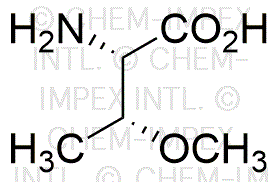O-Methyl-L-threonine is widely utilized in research focused on:
- Pharmaceutical Development: This compound serves as a key intermediate in synthesizing various pharmaceuticals, particularly those targeting metabolic disorders.
- Biochemical Research: It is used in studies investigating amino acid metabolism, helping researchers understand its role in protein synthesis and cellular functions.
- Nutrition Science: O-Methyl-L-threonine is explored for its potential benefits in dietary supplements aimed at enhancing amino acid profiles for athletes and individuals with specific nutritional needs.
- Plant Biology: The compound is applied in agricultural research to study its effects on plant growth and development, potentially leading to improved crop yields.
- Neuroscience: Researchers are investigating its effects on neurotransmitter activity, which could open avenues for developing treatments for neurological disorders.
General Information
Properties
Safety and Regulations
Applications
O-Methyl-L-threonine is widely utilized in research focused on:
- Pharmaceutical Development: This compound serves as a key intermediate in synthesizing various pharmaceuticals, particularly those targeting metabolic disorders.
- Biochemical Research: It is used in studies investigating amino acid metabolism, helping researchers understand its role in protein synthesis and cellular functions.
- Nutrition Science: O-Methyl-L-threonine is explored for its potential benefits in dietary supplements aimed at enhancing amino acid profiles for athletes and individuals with specific nutritional needs.
- Plant Biology: The compound is applied in agricultural research to study its effects on plant growth and development, potentially leading to improved crop yields.
- Neuroscience: Researchers are investigating its effects on neurotransmitter activity, which could open avenues for developing treatments for neurological disorders.
Documents
Safety Data Sheets (SDS)
The SDS provides comprehensive safety information on handling, storage, and disposal of the product.
Product Specification (PS)
The PS provides a comprehensive breakdown of the product’s properties, including chemical composition, physical state, purity, and storage requirements. It also details acceptable quality ranges and the product's intended applications.
Certificates of Analysis (COA)
Search for Certificates of Analysis (COA) by entering the products Lot Number. Lot and Batch Numbers can be found on a product’s label following the words ‘Lot’ or ‘Batch’.
*Catalog Number
*Lot Number
Certificates Of Origin (COO)
This COO confirms the country where the product was manufactured, and also details the materials and components used in it and whether it is derived from natural, synthetic, or other specific sources. This certificate may be required for customs, trade, and regulatory compliance.
*Catalog Number
*Lot Number
Safety Data Sheets (SDS)
The SDS provides comprehensive safety information on handling, storage, and disposal of the product.
DownloadProduct Specification (PS)
The PS provides a comprehensive breakdown of the product’s properties, including chemical composition, physical state, purity, and storage requirements. It also details acceptable quality ranges and the product's intended applications.
DownloadCertificates of Analysis (COA)
Search for Certificates of Analysis (COA) by entering the products Lot Number. Lot and Batch Numbers can be found on a product’s label following the words ‘Lot’ or ‘Batch’.
*Catalog Number
*Lot Number
Certificates Of Origin (COO)
This COO confirms the country where the product was manufactured, and also details the materials and components used in it and whether it is derived from natural, synthetic, or other specific sources. This certificate may be required for customs, trade, and regulatory compliance.


